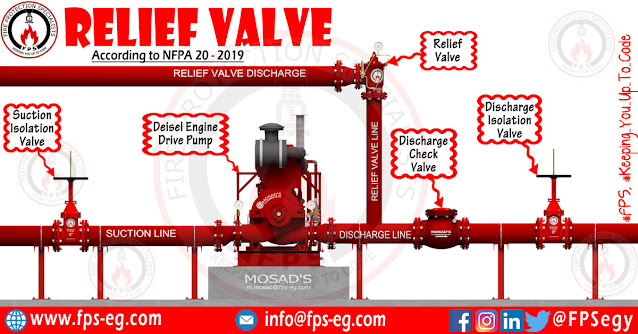Relief Valves for Centrifugal Pumps According to NFPA 20
Relief Valves for Centrifugal Pumps According to NFPA 20
What is relief valve?
A device that allows the diversion of liquid to limit excess pressure in a system.
Where shall we install relief valve?
relief valve shall be installed for centrifugal pumps in only two cases:
- For diesel engine fire pump: Where a total of 121% of the net rated shutoff (churn) pressure plus the maximum static suction pressure, adjusted for elevation, exceeds the pressure for which the system components are rated.
- For electric variable speed pump or a diesel pressure limiting driver: Where the maximum total discharge head adjusted for elevation with the pump operating at shutoff and rated speed exceeds the pressure rating of the system components.
Sizing of relief valve:
- The relief valve size & its discharge pipe shall not be less than that given in table below, or sized hydraulically to discharge sufficient water to prevent the pump discharge pressure, adjusted for elevation, from exceeding the pressure rating of the system components.
- If the discharge pipe employs more than one elbow, the next larger pipe size shall be used.
 |
| Relief Valve sizing According to NFPA 20 |
Location of relief valve:
- Relief valve shall be located between the pump and the pump discharge check valve.
Types of relief valve:
- Listed spring-loaded
- Pilot-operated diaphragm type.
Discharge of relief valve:
- The relief valve shall discharge into an open pipe or into a cone or funnel secured to the outlet of the valve, Water discharge from the relief valve shall be readily visible.
Notes on installation of relief valve:
- A shutoff valve shall not be installed in the relief valve supply or discharge piping.
- Relief valve discharge piping returning water back to the supply source, such as an above-ground storage tank, shall not be combined with the discharge from other relief valves.
- Relief valve discharge piping from a single fire pump returning water back to the supply source shall be permitted to be combined with fire pump test piping downstream of any control valve.
- The discharge piping from multiple relief valves shall not be combined with fire pump test piping.
- Isolation of the test header piping from the pressure relief valve discharge shall be possible.
- where a pressure relief valve has been piped back to suction, a circulation relief valve discharges to atmosphere shall be provided downstream of the pressure relief valve, and shall actuate below the opening set point of the pressure relief valve to ensure cooling of the pump during churn operation.
- Where the supply of water to the pump is taken from a suction reservoir of limited capacity, the drain pipe shall discharge into the reservoir at a point as far from the pump suction to prevent the pump from drafting air introduced by the drain pipe discharge.
REFERENCES OF THIS ARTICLE:
NFPA 20 - 2019 edition. (Standard for the Installation of Stationary Pumps for Fire Protection)READ ALSO:
SPRINKLER CHARACTERISTICS ACCORDING TO NFPA 13SPRINKLERS IN ELECTRICAL ROOMS ACCORDING TO NFPA 13
FIRE DEPARTMENT CONNECTION ACCORDING TO NFPA 13
SEISMIC SEPARATION ASSEMBLY
RETURN BEND REQUIREMENTS ACCORDING TO NFPA 13
DISTANCE BELOW CEILING FOR STANDARD PENDANT & UPRIGHT SPRINKLERS
SPRINKLER DISTRIBUTION IN SMALL ROOMS - NFPA 13
Fire Protection Specialists
Keeping You Up To Code












We are manufacturing for carbon steel forged and butt weld fittings in india
ReplyDeleteMy contact number 7733848383
DeleteExcellent and very exciting site. Love to watch. Keep Rocking. Plumbers in Glendale CA
ReplyDeletewhat if the relief valve is used to reduce psi so much that the pump is dumping or circulating over 1oo percent of pump capacity or even 150 percent causing motor or diesel to run in the service factor amps or hp
ReplyDeleteI your writing style genuinely loving this site. get redirected here
ReplyDeletegörüntülüshow
ReplyDeleteücretli show
7JAN
Fire trucks stand for dedication. used fire trucks
ReplyDelete